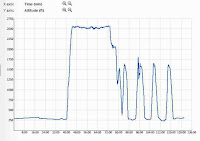My prep work was much more extensive this week. I 'flew' every checklist at least once, ran numerous flight plans through the simulators, pulled out the POH and went over some the systems pages, and in general thought a lot about what I was trying to do. I arrived at the airport much more confident and ready to fly.

Objective; finish up the enroute procedures, correctly enter the terminal area and fully exercise "George". The CFII choose to go to Schuylkill County /Joe Zerbey (ZER), POTTSVILLE, PA, Elevation: 1729. Looked to be about a 20 minute trip which should give me time to exercise the system, and myself.
Preflight was normal. Clean oil and a loose screw on an access panel meant she had probably just finished a 100 hour inspection. Ground work was all normal as was the takeoff. We had the opportunity to go through the Auto Lean procedure and with checklist complete began concentrating on the MFD. Charts, trip and nearest pages as well as a review of the weather information (there was some turbulence out there due to the heat).

Next my focus switched to terminal procedures. 12 miles out so I started to get the plane ready. MFD said the airport was on the nose...but I didn't see it. 8 miles, still not in sight. So I triple checked the MFD and it appeared to be just beyond I81 on the other side of the mountain. 5 miles, no joy. At this point the CFII suggested I change the range on the display and with that it became clear that KZER was not in a valley but on the ridge. Beautiful.
Not the best entry I've ever done. But a good lesson in using the available information in the plane to understand the 'lay of the land' and how to make adjustments for a VFR landing pattern.
This was a great choice to do some landing practice. The steep drop offs forced me to concentrate on the runway and the proper procedures. I had a misconception about the deployment of the first notch of flaps which the CFII finally corrected, and there were a few other kinks that I was finally getting straightened. Not perfection...but close to competent, and my comfort level is getting better all the time. I can be trained.
 So we departed there and headed for home. I used the system resources to monitor the trip, and was introduced to the Cirrus Satellite Entertainment System. No joke, cool stuff. We discussed and input the GPS 06 approach (Circle to Land) using vertical guidance on the GNS430. That is a page I had not seen before which I think will be very useful. (When do you begin your descent?)
So we departed there and headed for home. I used the system resources to monitor the trip, and was introduced to the Cirrus Satellite Entertainment System. No joke, cool stuff. We discussed and input the GPS 06 approach (Circle to Land) using vertical guidance on the GNS430. That is a page I had not seen before which I think will be very useful. (When do you begin your descent?)We broke off the approach at pattern altitude, made the necessary transitions to enter the pattern for a full stop at home. (I blew the landing...too nose high...I hate that.) Taxi back, shutdown, etc all normal.
I'm getting there.
Sr20
Time = 1.9 hours












